#Speech and voice recognition technology Epidemiology
Explore tagged Tumblr posts
Text
The Role of Voice Technology in Improving Telemedicine Experiences
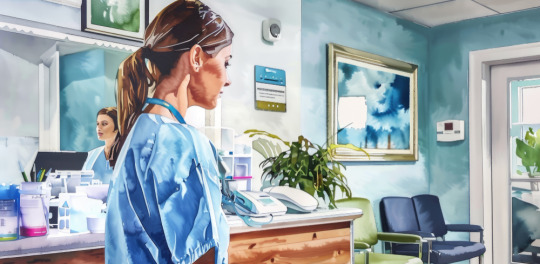
Introduction
Speech and voice recognition technology has been a game-changer in numerous industries, and healthcare is no exception. With the rapid integration of AI and other technological advancements, speech and voice recognition in healthcare are transforming the way patient care is delivered, recorded, and analyzed. These technologies enhance communication, reduce administrative burdens, and improve overall efficiency within healthcare settings. As healthcare trends like telemedicine continue to grow, speech and voice recognition technology is playing a critical role in shaping the future of healthcare.
Key Benefits of Speech and Voice Recognition Technology in Healthcare
1. Enhanced Efficiency and Time Savings
One of the most immediate and noticeable impacts of speech and voice recognition technology in healthcare is the reduction of time spent on documentation and administrative tasks. Traditionally, healthcare professionals spend a significant amount of time documenting patient information in Electronic Health Records (EHRs). By integrating voice recognition technology, clinicians can dictate their notes, and the system converts spoken words into text.
Benefit: This allows doctors, nurses, and medical practitioners to spend more time focusing on patient care rather than being bogged down by time-consuming paperwork.
Impact: Increased efficiency leads to more patients being seen per day, better utilization of staff time, and fewer chances for burnout.
2. Improved Accuracy and Reduced Human Error
Manual data entry into EHR systems is prone to errors, which can have significant consequences in patient care. Speech and voice recognition technology dramatically reduces the likelihood of typographical and input errors, ensuring that patient information is accurately documented.
Impact: This leads to better quality of care, fewer misdiagnoses, and improved patient safety.
3. Streamlined Workflow for Healthcare Professionals
With voice commands, healthcare professionals can quickly retrieve patient information, update records, and even issue prescriptions or medical orders without needing to manually navigate through systems. Speech and voice recognition in healthcare enables clinicians to seamlessly interact with their digital systems, allowing for hands-free operation in many cases.
Impact: This significantly enhances workflow, especially in fast-paced environments like emergency rooms, operating rooms, and intensive care units.
Impact on Telemedicine and Remote Care
1. Integration with Telemedicine
As healthcare trends like telemedicine become more prevalent, speech and voice recognition technology is playing a crucial role in making remote consultations more efficient. Doctors can utilize speech-to-text technology during virtual consultations to document patient interactions in real-time, ensuring that all relevant details are captured and recorded accurately.
Benefit: This enhances the quality of remote consultations, improves patient care, and reduces the risk of errors in telehealth settings.
Impact: It enables a smoother and more professional experience for both healthcare providers and patients, particularly when multiple consultations are being handled remotely.
2. Improved Accessibility
For patients with physical disabilities or those unable to use traditional input methods (e.g., keyboard or mouse), speech recognition provides a vital communication tool. This includes patients with visual impairments or those suffering from conditions like arthritis, where using hands for typing may be difficult.
Impact: Speech and voice recognition technology makes healthcare more accessible, enabling these individuals to participate more actively in their own care, whether during remote consultations or in-person visits.
Integration of Artificial Intelligence (AI) with Speech and Voice Recognition
1. AI-Powered Insights for Decision Making
When AI integration is combined with speech and voice recognition technology, it can enhance decision-making by analyzing the spoken input from healthcare professionals. AI algorithms can process medical data, suggest potential diagnoses, and even flag potential drug interactions based on voice-driven documentation.
Benefit: AI-powered insights can assist healthcare providers in making more informed, data-driven decisions quickly.
Impact: This reduces the likelihood of human error and accelerates decision-making, particularly in complex medical cases.
2. Predictive Analytics and Clinical Decision Support
AI-enhanced speech and voice recognition technology not only transcribes voice but can also analyze the context of what is being said to provide real-time feedback or alerts. For example, AI systems can identify patterns in a physician’s verbal notes or inquiries, helping flag critical conditions like sepsis or early signs of disease progression.
Impact: This predictive capability improves early diagnosis and ensures timely interventions, which can ultimately save lives.
Privacy and Security Considerations
1. Ensuring Compliance with Healthcare Regulations
With the adoption of speech and voice recognition technology, maintaining the privacy and confidentiality of patient information becomes even more critical. Healthcare systems must ensure that these technologies comply with HIPAA (Health Insurance Portability and Accountability Act) and other privacy regulations.
Impact: Strong encryption, secure data storage, and compliance with healthcare regulations will help protect patient privacy while making the most of these technologies.
2. Reducing Errors through Speech Accuracy
Voice recognition tools have become more sophisticated in their ability to differentiate between medical terminology, accents, and languages. As these technologies continue to improve, they will reduce errors in transcription, making it easier for providers to rely on voice recognition for critical documentation without compromising accuracy.
Impact: This will be especially important in multilingual environments where clear communication is key to patient safety.
Challenges in Implementing Speech and Voice Recognition in Healthcare
While the advantages of speech and voice recognition in healthcare are undeniable, there are still some challenges to overcome:
Learning Curve and Adaptability: Healthcare providers need time to adapt to these technologies, and there may be a learning curve associated with effectively utilizing speech recognition systems.
Accuracy in Noisy Environments: Hospitals and clinics are often noisy, which can impact the accuracy of voice recognition systems. This could be addressed through noise-cancelling technologies and further refinement of speech recognition algorithms.
Cost of Implementation: Although the long-term benefits are clear, the upfront costs of implementing speech and voice recognition systems, especially in large healthcare systems, can be high.
Integration with Legacy Systems: Many healthcare facilities use outdated electronic health record systems, and integrating advanced speech and voice recognition tools with these systems can be a complex and resource-intensive process.
Conclusion
Speech and voice recognition technology is transforming healthcare, offering immense potential to improve efficiency, accuracy, and accessibility for both providers and patients. As healthcare trends like telemedicine continue to expand and AI integration becomes more advanced, the role of voice-driven systems will grow even further. The ability to streamline documentation, enhance decision-making, and improve patient care are just some of the many benefits that these technologies bring. However, for full integration and maximum benefit, healthcare systems must also address the challenges associated with implementation, security, and adaptability. With ongoing advancements, speech and voice recognition in healthcare will continue to shape the future of patient care delivery.
Latest Healthcare Market Research Reports:
Undifferentiated Pleomorphic Sarcoma Market | Audiology Devices Market | Ductal Carcinoma In Situ Market | Hemodynamic Monitoring System Market | Synchronous Endometrial And Ovarian Carcinoma Market | Acute Pyelonephritis Market | Adeno-associated Virus Aav Vectors In Gene Therapy Market | Adenosine Deaminase-severe Combined Immunodeficiency Market | Cell And Gene Therapy For Multtiple Myeloma Market | Chemotherapy Induced Nausea And Vomiting Market | Crows Feet Market | Desmoplastic Small Round Cell Tumors Dsrcts Market
#Speech and voice recognition technology#Speech and voice recognition technology Market#Speech and voice recognition technology Forecast#Speech and voice recognition technology Companies#Speech and voice recognition technology Therapies#Speech and voice recognition technology Epidemiology#Speech and voice recognition technology Pipeline#Speech and voice recognition technology Market Size#Speech and voice recognition technology Market Trends
0 notes
Text
Pluralistic, your daily link-dose: 28 Feb 2020

Today's links
Clearview AI's customer database leaks: Sic semper grifter.
The Internet of Anal Things: Recreating Stelarc's "Amplified Body" with an IoT butt-plug.
Oakland's vintage Space Burger/Giant Burger building needs a home! Adopt a googie today.
Fan-made reproduction of the Tower of Terror: Even has a deepfaked Serling.
Drawing the Simpsons with pure CSS: Impractical, but so impressive.
Let's Encrypt issues its billionth cert: 89% of the web is now encrypted.
AI Dungeon Master: A work in progress, for sure.
How to lie with (coronavirus) maps: Lies, damned lies, and epidemiological data-visualizations.
This day in history: 2019, 2015
Colophon: Recent publications, current writing projects, upcoming appearances, current reading
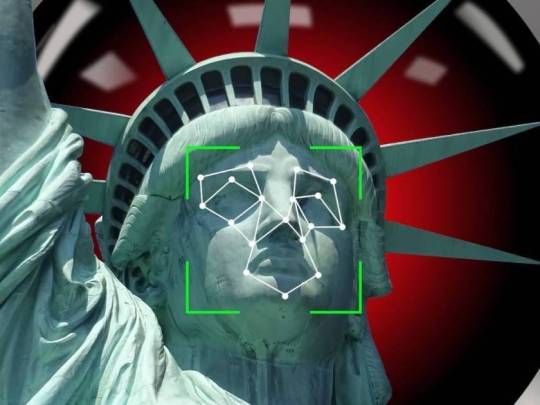
Clearview AI's customer database leaks (permalink)
Clearview is the grifty facial recognition startup that created a database by scraping social media and now offers cops secretive deals on its semi-magic, never-peer-reviewed technology. The company became notorious in January after the NYT did a deep dive into its secretive deals and its weird, Trump-adjascent ex-male-model founder.
(the Times piece was superbly researched but terribly credulous about Clearview's marketing claims)
https://www.nytimes.com/2020/01/18/technology/clearview-privacy-facial-recognition.html
Yesterday, Clearview warned its customers that it had been hacked and lost its customer database. Today, that customer database was published.
https://www.buzzfeednews.com/article/ryanmac/clearview-ai-fbi-ice-global-law-enforcement
It seems that the NYT weren't the only ones to take Clearview's marketing claims at face value. Its client list includes the DoJ, ICE, Macy's, Walmart, and the NBA. All in all the dump includes more than 2,200 users, including "law enforcement agencies, companies, and individuals around the world."
Included: state AGs, university rent-a-cops, and clients in Saudi Arabia.
"BuzzFeed News authenticated the logs, which list about 2,900 institutions and include details such as the number of log-ins, the number of searches, and the date of the last search."
What does Clearview, a sercurity company, say about this ghastly security breach? "Unfortunately, data breaches are part of life in the 21st century."
Big shrug energy.
"Government agents should not be running our faces against a shadily assembled database of billions of our photos in secret and with no safeguards against abuse," ACLU attorney Nathan Freed Wessler, said to BuzzFeed News.
It is amazing that this needs to be said.
"More than 50 educational institutions across 24 states named in the log. Among them are two high schools."
They are:
Central Montco Technical High School in Pennsylvania
Somerset Berkley Regional High School in Massachusetts
The log also has an entry for Interpol.

The Internet of Anal Things (permalink)
In 1994, the notorious/celebrated electronic artist Stelarc did a performance called "Amplified Body" in which he "controlled robots, cameras and other instruments by tensing and releasing his muscles"
https://web.archive.org/web/20120712181429/https://v2.nl/events/amplified-body
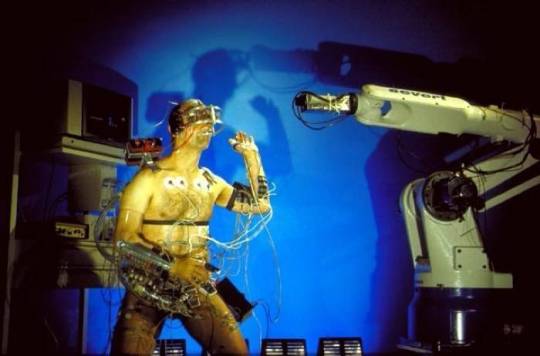
Now, artist/critic Dani Ploeger has revisited Amplified Body with his own performance, which is very similar to Stelarc's, except all the peripherals are controlled by Ploeger tensing and releasing his anal sphincters around a smart butt-plug.
https://www.daniploeger.org/amplified-body
He calls it "B-hind" and it's a ha-ha-only-serious. The buttplug is "an anal electrode with EMG sensor for domestic treatment of faecal incontinence," and the accompanying text is a kind of art-speak parody of IoT biz-speak.
https://we-make-money-not-art.com/b-hind-celebrating-the-internet-of-anal-things
"B-hind offers a unique IoT solution to fully integrate your sphincter muscle in everyday living. The revolutionary anal electrode-powered interface system replaces conventional hand/voice-based interaction, enabling advanced digital control rooted in your body's interior. Celebrating the abject and the grotesque, B‒hind facilitates simple, plug-and-play access to a holistic body experience in the age of networked society."
B-hind was produced in collaboration with V2_, the Lab for the Unstable Media in Rotterdam, and In4Art.

Oakland's vintage Space Burger/Giant Burger building needs a home! (permalink)
Giant Burger was once an East Bay institution, known for its burgers and its gorgeous googie architecture.
https://localwiki.org/oakland/Giant_Burger
One of the very last Giant Burger buildings is now under threat. Though the Telegraph Ave location was rescued in 2015 and converted to a "Space Burger," it's now seeking a new home because it is in the path of the Eastline project.
https://insidescoopsf.sfgate.com/blog/2015/02/24/space-burger-launches-in-uptown-oakland/
The Oakland Heritage Alliance is hoping someone will rescue and move the building: " Do you have an idea for a new location for this mid-century icon? Please contact [email protected] if you know of an appropriate lot, project, or site, preferably downtown."
(Image CC BY-SA, Our Oakland)

Fan-made reproduction of the Tower of Terror (permalink)
Orangele set out to re-create the Walt Disney World Twilight Zone Tower of Terror elevator loading zone in the entry area to their home theater. He's not only done an impressive re-make of the set, but he's also augmented it with FANTASTIC gimmicks.
https://www.hometheaterforum.com/community/threads/the-tower-of-terror-theater.365747/
It's not merely that's he's created a rain, thunder and lightning effect outside the patio doors…

https://www.youtube.com/watch?v=4QMzN0v4mJQ
Nor has he merely created props like this gimmicked side table that flips over at the press of a button.
https://www.youtube.com/watch?v=kY7gQLMnbeA
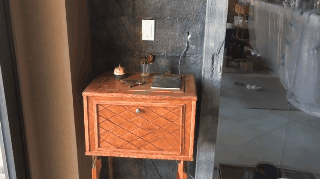
He's also created HIS OWN ROD SERLING DEEPFAKE.
https://www.youtube.com/watch?time_continue=2&v=MIsjYJwOXSU

I kinda seriously love that he left Rod's cigarette in. The Disney version looks…uncanny.
Not shown: "exploding fuse box with simulated smoke and fire, motorized lighted elevator dial, motorized/lighted pressure gauge, video monitor playing Tower of Terror ride sequence seen through the elevator door wrap, motorized "elevator door'"
He notes, "I was once married, but now as a single person, I can do whatever I want, haha. NEVER getting married again."
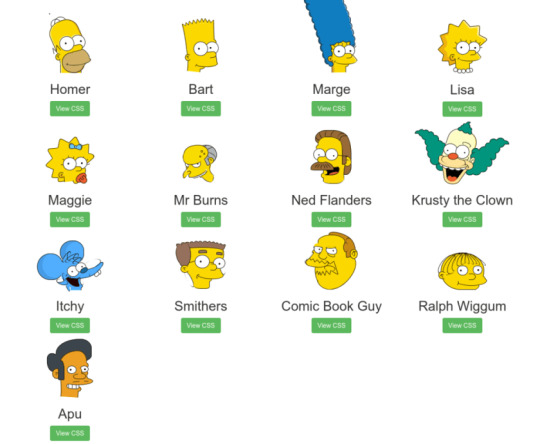
Drawing the Simpsons with pure CSS (permalink)
Implementing animated Simpsons illustrations in CSS isn't the most practical web-coding demo I've seen, but it's among the most impressive. Bravo, Chris Pattle!
(not shown: the eyes animate and blink!)
https://pattle.github.io/simpsons-in-css/
#bart .head .hair1 { top: 22px; left: 0px; width: 6px; height: 7px; -webkit-transform: rotate(-22deg) skew(-7deg, 51deg); -ms-transform: rotate(-22deg) skew(-7deg, 51deg); transform: rotate(-22deg) skew(-7deg, 51deg); }
I especially love the quick-reference buttons to see the raw CSS. It reminds me of nothing so much as the incredibly complex Logo programs I used to write on my Apple ][+ in the 1980s, drawing very complicated, vector-based sprites and glyphs.
https://github.com/pattle/simpsons-in-css/blob/master/css/bart.css
Most interesting is the way that this modular approach to graphics allows for this kind of simple, in-browser transformation.

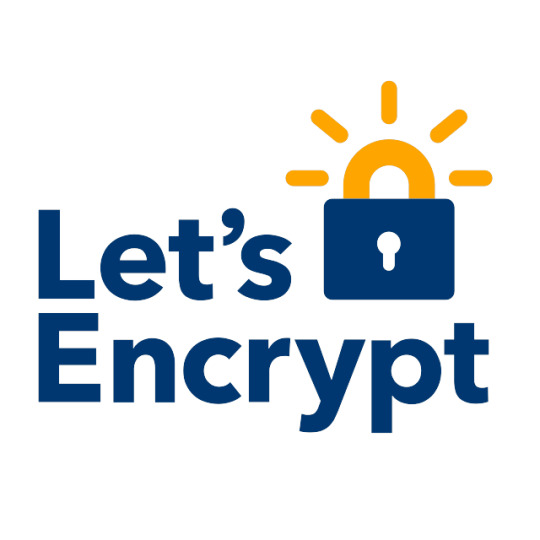
Let's Encrypt issues its billionth cert (permalink)
When the AT&T whistleblower Mark Klein walked into EFF's offices in 2005 to reveal that his employers had ordered him to help the NSA spy on the entire internet, it was a bombshell.
https://www.eff.org/tags/mark-klein
The Snowden papers revealed the scope of the surveillance in fine and alarming detail. According to his memoir, Snowden was motivated to blow the whistle when he witnessed then-NSA Director James Clapper lie to Senator Ron Wyden about the Klein matter.
Since that day in 2005, privacy advocates have been fretting about just how EASY it was to spy on the whole internet. So much of that was down to the fact that the net wasn't encrypted by default.
This was especially keen for @EFF. After all, we made our bones by suing the NSA in the 90s and winning the right for civilians to access working cryptography (we did it by establishing that "Code is speech" for the purposes of the First Amendment).
https://www.eff.org/deeplinks/2015/04/remembering-case-established-code-speech
Crypto had been legal since 1992, but by Klein's 2005 disclosures, it was still a rarity. 8 years later — at the Snowden moment — the web was STILL mostly plaintext. How could we encrypt the web to save it from mass surveillance?
So in 2014, we joined forces with Mozilla, the University of Michigan and Akamai to create Let's Encrypt, a project to give anyone and everyone free TLS certificates, the key component needed to encrypt the requests your web-server exchanges with your readers.
https://en.wikipedia.org/wiki/Let%27s_Encrypt
Encrypting the web was an uphill climb: by 2017, Let's Encrypt had issued 100m certificates, tipping the web over so that the majority of traffic (58%) was encrypted. Today, Let's Encrypt has issued ONE BILLION certs, and 81% of pageloads use HTTPS (in the USA, it's 91%)! This is astonishing, bordering on miraculous. If this had been the situation back in 2005, there would have been no NSA mass surveillance.
Even more astonishing: there are only 11 full-timers on the Let's Encrypt team, plus a few outside contractors and part-timers. A group of people who could fit in a minibus managed to encrypt virtually the entire internet.
https://letsencrypt.org/2020/02/27/one-billion-certs.html
There are lots of reasons to factor technology (and technologists) in any plan for social change, but this illustrates one of the primary tactical considerations. "Architecture is Politics" (as Mitch Kapor said when he co-founded EFF), and the architectural choices that small groups of skilled people make can reach all the way around the world.
This kind of breathtaking power is what inspires so many people to become technologists: the force-multiplier effect of networked code can imbue your work with global salience (for good or ill). It's why we should be so glad of the burgeoning tech and ethics movement, from Tech Won't Build It to the Googler Uprising. And it's especially why we should be excited about the proliferation of open syllabi for teaching tech and ethics.
https://docs.google.com/spreadsheets/d/1jWIrA8jHz5fYAW4h9CkUD8gKS5V98PDJDymRf8d9vKI/edit#gid=0
It's also the reason I'm so humbled and thrilled when I hear from technologists that their path into the field started with my novel Little Brother, whose message isn't "Tech is terrible," but, "This will all be so great, if we don't screw it up."
https://craphound.com/littlebrother
(and I should probably mention here that the third Little Brother book, Attack Surface, comes out in October and explicitly wrestles with the question of ethics, agency, and allyship in tech).
https://us.macmillan.com/books/9781250757531
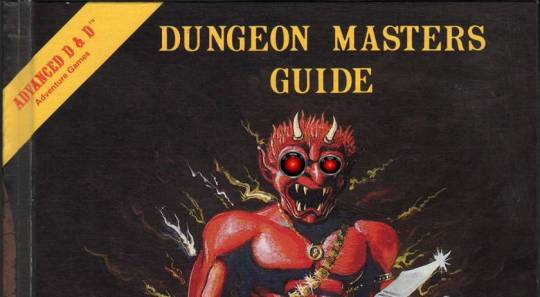
AI Dungeon Master (permalink)
Since 2018, Lara martin has been using machine learning to augment the job of the Dungeon Master, with the goal of someday building a fully autonomous, robotic DM.
https://laramartin.net/
AI Dungeon Master is a blend of ML techniques and "old-fashioned rule-based features" to create a centaur DM that augments a human DM's imagination with the power of ML, natural language processing, and related techniques.
She's co-author of a new paper about the effort, "Story Realization: Expanding Plot Events into Sentences" which "describes a way algorithms to use "events," consisting of a subject, verb, object, and other elements, to make a coherent narrative."
https://aaai.org/Papers/AAAI/2020GB/AAAI-AmmanabroluP.6647.pdf
The system uses training data (plots from Doctor Who, Futurama, and X-Files) to expand text-snippets into plotlines that continue the action. It's a bit of a dancing bear, though, an impressive achievement that's not quite ready for primetime ("We're nowhere close to this being a reality yet").
https://www.wired.com/story/forget-chess-real-challenge-teaching-ai-play-dandd/
This may bring to mind AI Dungeon, the viral GPT-2-generated dungeon crawler from December.
https://aidungeon.io/
As Will Knight writes, "Playing AI Dungeon often feels more like a maddening improv session than a text adventure."
Knight proposes that "AI DM" might be the next big symbolic challenge for machine learning, the 2020s equivalent to "AI Go player" or "AI chess master."
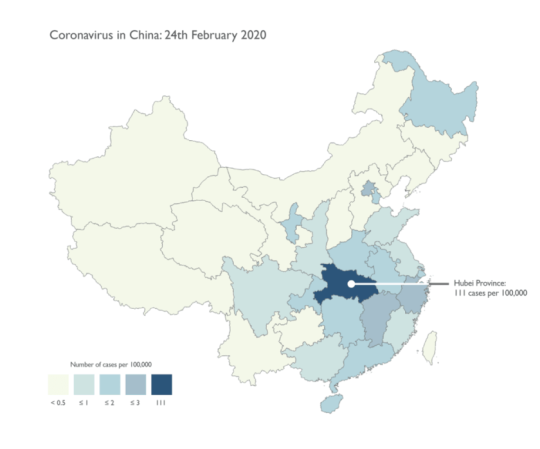
How to lie with (coronavirus) maps (permalink)
The media around the coronavirus outbreak is like a masterclass in the classic "How to Lie With Maps."
https://www.press.uchicago.edu/ucp/books/book/chicago/H/bo27400568.html
Self-described "cartonerd" Kenneth Field's prescriptions for mapmakers wanting to illustrate the spread of coronavirus is a superb read about data visualization, responsibility, and clarity.
https://www.esri.com/arcgis-blog/products/product/mapping/mapping-coronavirus-responsibly/
Both of these images are representing the same data. Look at the map and you might get the impression that coronavirus infections are at high levels across all of China's provinces. Look at the bar-chart and you'll see that it's almost entire Hubei.
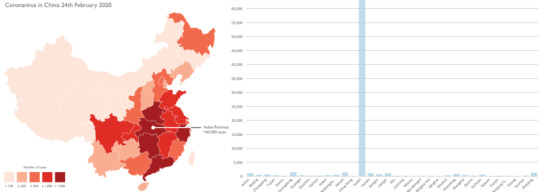
Here's a proposed way to represent the same data on a map without misleading people.

Another point that jumped out: stop coloring maps in red!
"We're mapping a human health tragedy that may get way worse before it subsides. Do we really want the map to be screaming bright red? Red can connotate death, still statistically extremely rare for coronavirus."

This day in history (permalink)
#5yrsago Ad-hoc museums of a failing utopia: photos of Soviet shop-windows https://boingboing.net/2015/02/28/ad-hoc-museums-of-a-failing-ut.html
#5yrsago First-hand reports of torture from Homan Square, Chicago PD's "black site" https://www.theguardian.com/us-news/2015/feb/27/chicago-abusive-confinment-homan-square
#1yrago EFF's roadmap for a 21st Century antitrust doctrine https://www.eff.org/deeplinks/2019/02/antitrust-enforcement-needs-evolve-21st-century
#1yrago Yet another study shows that the most effective "anti-piracy" strategy is good products at a fair price https://www.vice.com/en_us/article/3kg7pv/studies-keep-showing-that-the-best-way-to-stop-piracy-is-to-offer-cheaper-better-alternatives
#1yrago London's awful estate agents are cratering, warning of a "prolonged downturn" in the housing market https://www.bbc.com/news/business-47389160
#1yrago Bad security design made it easy to spy on video from Ring doorbells and insert fake video into their feeds https://web.archive.org/web/20190411195308/https://dojo.bullguard.com/dojo-by-bullguard/blog/ring/
#1yrago Amazon killed Seattle's homelessness-relief tax by threatening not to move into a massive new building, then they canceled the move anyway https://www.seattletimes.com/business/amazon/huge-downtown-seattle-office-space-that-amazon-had-leased-is-reportedly-put-on-market/
#1yrago The "Reputation Management" industry continues to depend on forged legal documents https://www.techdirt.com/articles/20190216/15544941616/pissed-consumer-exposes-new-york-luxury-car-dealers-use-bogus-notarized-letters-to-remove-critical-reviews.shtml

Colophon (permalink)
Today's top sources: Allegra of Oakland Heritage Alliance, Waxy (https://waxy.org/), We Make Money Not Art (https://we-make-money-not-art.com/), Sam Posten (https://twitter.com/Navesink), Slashdot (https://slashdot.org), Kottke (https://kottke.org) and Four Short Links (https://www.oreilly.com/feed/four-short-links).
Hugo nominators! My story "Unauthorized Bread" is eligible in the Novella category and you can read it free on Ars Technica: https://arstechnica.com/gaming/2020/01/unauthorized-bread-a-near-future-tale-of-refugees-and-sinister-iot-appliances/
Upcoming appearances:
Canada Reads Kelowna: March 5, 6PM, Kelowna Library, 1380 Ellis Street, with CBC's Sarah Penton https://www.eventbrite.ca/e/cbc-radio-presents-in-conversation-with-cory-doctorow-tickets-96154415445
Currently writing: I just finished a short story, "The Canadian Miracle," for MIT Tech Review. It's a story set in the world of my next novel, "The Lost Cause," a post-GND novel about truth and reconciliation. I'm getting geared up to start work on the novel now, though the timing is going to depend on another pending commission (I've been solicited by an NGO) to write a short story set in the world's prehistory.
Currently reading: Just started Lauren Beukes's forthcoming Afterland: it's Y the Last Man plus plus, and two chapters in, it's amazeballs. Last week, I finished Andrea Bernstein's "American Oligarchs" this week; it's a magnificent history of the Kushner and Trump families, showing how they cheated, stole and lied their way into power. I'm getting really into Anna Weiner's memoir about tech, "Uncanny Valley." I just loaded Matt Stoller's "Goliath" onto my underwater MP3 player and I'm listening to it as I swim laps.
Latest podcast: Gopher: When Adversarial Interoperability Burrowed Under the Gatekeepers' Fortresses: https://craphound.com/podcast/2020/02/24/gopher-when-adversarial-interoperability-burrowed-under-the-gatekeepers-fortresses/
Upcoming books: "Poesy the Monster Slayer" (Jul 2020), a picture book about monsters, bedtime, gender, and kicking ass. Pre-order here: https://us.macmillan.com/books/9781626723627?utm_source=socialmedia&utm_medium=socialpost&utm_term=na-poesycorypreorder&utm_content=na-preorder-buynow&utm_campaign=9781626723627
(we're having a launch for it in Burbank on July 11 at Dark Delicacies and you can get me AND Poesy to sign it and Dark Del will ship it to the monster kids in your life in time for the release date).
"Attack Surface": The third Little Brother book, Oct 20, 2020.
"Little Brother/Homeland": A reissue omnibus edition with a very special, s00per s33kr1t intro.
7 notes
·
View notes